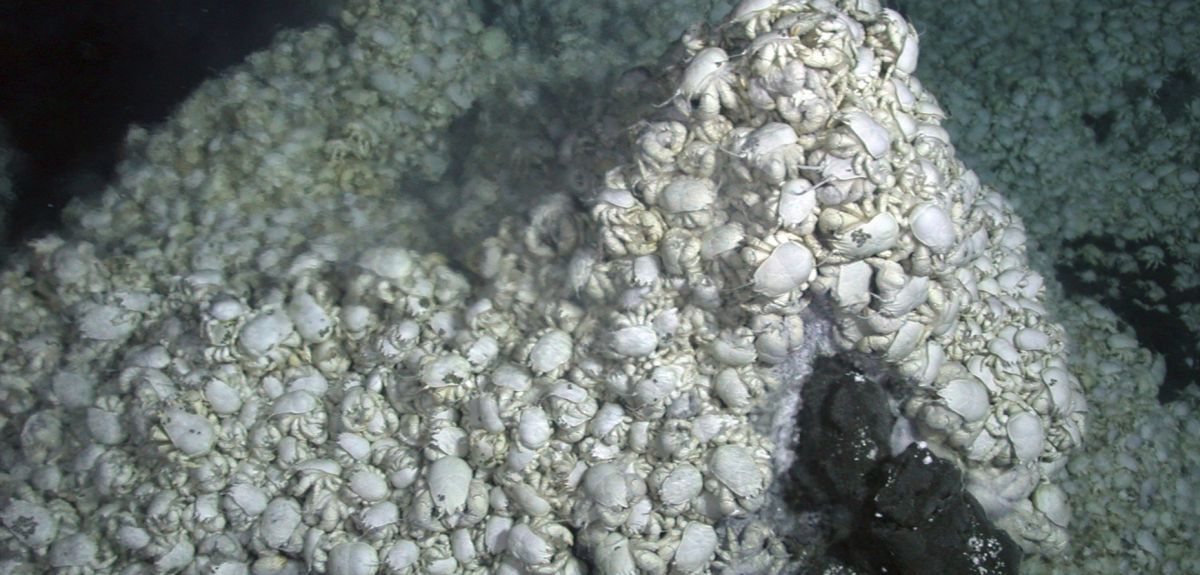
Origins of 'The Hoff' crab revealed
The history of a new type of crab, nicknamed 'The Hoff' because of its hairy chest, has been revealed for the first time.
A team led by Oxford University scientists has found that, far from being 'relics' marooned in their deep sea habitat, Yeti crabs (Kiwaidae) are, in evolutionary terms, relative newcomers that diversified 40 million years ago.
A report of this first genetic study into the evolution of Yeti crabs - which live around hydrothermal vents deep beneath the Southern Ocean and Indian Ocean - is published in this week's Proceedings of the Royal Society B.
The Hoff crabs, which have yet to be scientifically described and are probably two separate species, split off from their hairy-clawed Yeti cousins and spread eastwards over undersea ridges from the Pacific, through the Drake Passage between South America and Antarctica, to reach vents in the Southern and Indian Oceans.
Hoff crabs live in one of the most extreme environments on the planet - over 2000 metres under the sea, where volcanic vents superheat the water to c380 degrees Celsius and belch out noxious chemicals, and where there is no light and very little oxygen. They feed by, in effect, 'farming' bacteria on their hairy chests then using special comb-like mouthparts to 'strain off' the bacteria so that they can eat them.
Yet, despite their hardiness, the new research by scientists from Oxford University, the University of Southampton and British Antarctic Survey shows that their precarious lifestyle could leave them particularly vulnerable to changes in the oxygen levels of the oceans caused by global warming.
'The life of these charismatic crustaceans is a delicate balancing act,' says Nicolai Roterman of Oxford University's Department of Zoology who led the research and gave the crabs the 'Hoff' nickname.
'They need oxygen to survive, which is in short supply around the vents, but the bacteria they "farm" for food depend on chemicals only available near the vents. They exist in the narrow zone where the water from the vents and normal seawater mixes; their challenge is to position themselves close enough to the vents to thrive but not so close that they risk suffocating or getting cooked alive.'
It was once thought that - unlike land or shallow ocean dwellers - creatures living around deep-sea vents might be immune from the effects of extreme climate change, as the vent bacteria they feed on would be unaffected by surface weather patterns. However, a reappraisal of the ages of vent animals in another study suggests that, far from being ancient 'relics', most vent species diversified within the last 55 million years or so, with the previous inhabitants having gone extinct.
The reasons for this are unclear, but a period of intense global warming spanning several million years that started 55 million years ago and dramatically reduced deep-sea oxygen levels globally may be to blame.
The relatively recent origins of the Yeti crabs adds them to the list of vent animals that diversified after this extended episode of global warming and this new research seems to confirm a picture in which the inhabitants of deep-sea vents may be periodically wiped out and vents only repopulated by a wave of new species once conditions become favourable again.
During episodes of extreme global warming, circulation between the well-oxygenated surface waters and deeper down is thought to decline, leading to the gradual depletion of oxygen in the deep sea.
'Yeti crabs and other such creatures may in fact be especially prone to extinction when there is less oxygen available in the deep ocean,’ says Nicolai Roterman. 'This is because if deep-sea ocean oxygen levels fall, the amount of oxygen available to these animals - which already live in an oxygen-poor environment at the limits of their physiological tolerance - may drop below the minimum level at which they can survive.
'They would face the stark choice of "suffocate or starve".'
A report of the research, 'The biogeography of the yeti crabs (Kiwaidae) with notes on the phylogeny of the Chirostyloidea (Decapoda: Anomura)', is published in the journal Proceedings of the Royal Society B on 19 June 2013. The research was supported by the UK's Natural Environment Research Council.
 Expert Comment: What should we do about chatbots?
Expert Comment: What should we do about chatbots?
 Rapid, low-cost tests can help prevent child deaths from contaminated medicinal syrups
Rapid, low-cost tests can help prevent child deaths from contaminated medicinal syrups